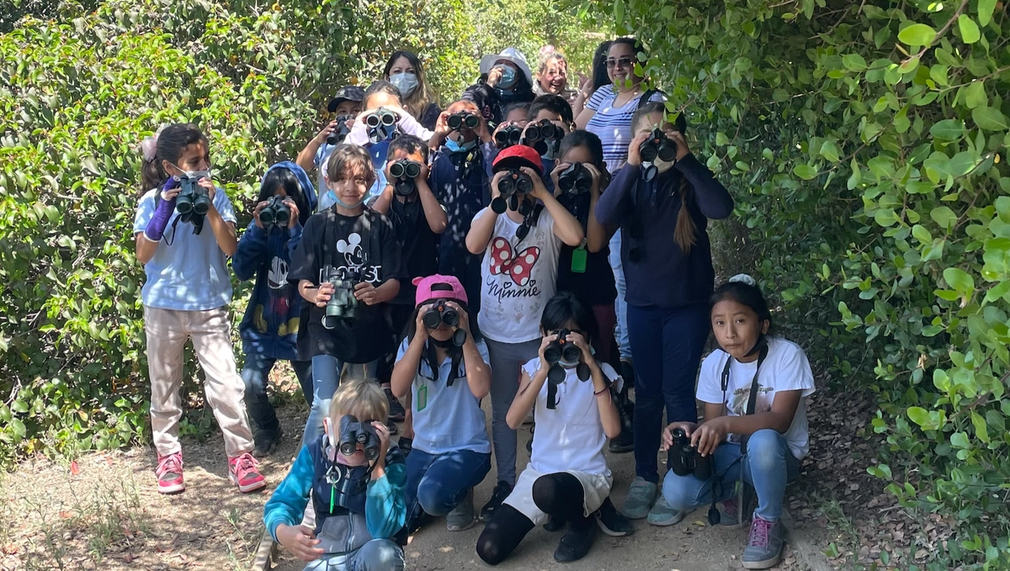Cultivating environmental champions through the excitement of birds
The goal of Pasadena Audubon Society's (PAS) Bird Science and Habitat Program (BSHP) is to bring conservation education, with a focus on local birds and native plants, to traditionally underserved K-5 public school children in greater Pasadena. By developing an appreciation of local birds and the ecosystem, we are building conservation values in these young people. Via classroom lessons, field trips and activities in the habitat garden, children witness ecosystem interactions and learn just how important conservation is in today’s world.

What is the primary issue area that your application will impact?
K-12 STEAM Education
In which areas of Los Angeles will you be directly working?
San Gabriel Valley
In what stage of innovation is this project, program, or initiative?
Expand existing project, program, or initiative
What is your understanding of the issue that you are seeking to address?
Children today are often disconnected from nature. The pandemic, with its virtual classrooms and constant screentime, has exacerbated this problem. Many schools offer asphalt covered playgrounds instead of gardens. Yet time spent in nature has proven benefits for human health and well-being. People living in neighborhoods with more birds, shrubs and trees are less likely to suffer from depression and anxiety, according to research at the Univ. of Exeter. At the same time, our planet and humanity are now facing two looming crises of our own making, climate change and biodiversity loss. Scientists increasingly understand that the two are linked. Audubon’s 2019 transverse study called Survival by Degrees, shows that two thirds of N. American bird species risk extinction from global temperature rise. If we lose the birds, we lose the ecosystem upon which we depend. We are all interdependent. We need a new generation of committed environmentalists to tackle these enormous problems.
Describe the project, program, or initiative this grant will support to address the issue.
The BSHP is designed to address the issues described above via meaningful environmental education complemented by schoolyard habitat gardens. We are cultivating environmental stewards in a traditionally underserved population, through daily exposure to nature at school and lessons which bring it all to life. K-5 students in the BSHP receive lessons on birds and conservation concepts which are in alignment with the Next Generation Sciences Standards. The program unfolds in 4 phases. 1/ Teachers receive lesson plans, program videos and activities and deliver them at their own pace before our visit. 2/ BSHP docents and interns visit the classroom to reinforce the lesson theme with additional activities and materials, such as nests and taxidermy, and to answer questions. 3/ Students visit a local park for a half day in nature, where they can see birds in their natural habitat. Each child uses birding binoculars to view birds with a guide, interacts with educational owls at close range and has time to enjoy the natural surroundings. Every component of this field trip is designed to build knowledge of birds, the ecosystem and conservation and to develop a sense of wonder and belonging in the natural world. 4/ The native habitat garden offers ongoing opportunities for children to explore nature throughout the year at their school. Our Garden Educator provides lessons and activities and engages the students and the community in garden maintenance.
Describe how Los Angeles County will be different if your work is successful.
PAS has been offering educational programming for many years. We have a track record of success which we measure by the number of young people coming out of our programs who choose to pursue higher education and careers in areas relating to the environment. This year Ashwin S. heads to Harvard to study Ecology and Biology. Dessi S. is doing the same at Stanford. Both have published research papers and are poised to make meaningful contributions to science which have the potential to impact conservation efforts in LA County and beyond. With the BSHP, we want to provide to a wider audience the same resources with which we have supported prior generations of young birders. We do not expect every child to become a birder or a scientist, but it is our hope that they all come to value nature, its creatures and understand how important it is to protect them. We are cultivating deeply committed future environmental advocates and this is key to addressing the issues described above.
What evidence do you have that this project, program, or initiative is or will be successful, and how will you define and measure success?
Surveys of teachers have shown very high levels of satisfaction with the BSHP. Overall, how would you rate Pasadena Audubon's Bird Science Habitat Program? Excellent 11/11 Would you like your class to participate in the program again? Definitely would 11/11 Some feedback provided: - For many of my English Learners and low-income students this was their first exposure to looking around their own habitat to see that it is shared with wildlife. For them to talk about protecting the birds by not leaving trash and especially food trash around was a big deal in my class. - Students were able to make a connection as they got to learn of common birds within our area. Mourning doves and crows became popular as they were easily identified for their unmistakable features and vocalization patterns throughout the school. We will continue to survey teachers and also consider developing student assessments to gauge the impact of the program.
Approximately how many people will be impacted by this project, program, or initiative?
Direct Impact: 820
Indirect Impact: 2,600